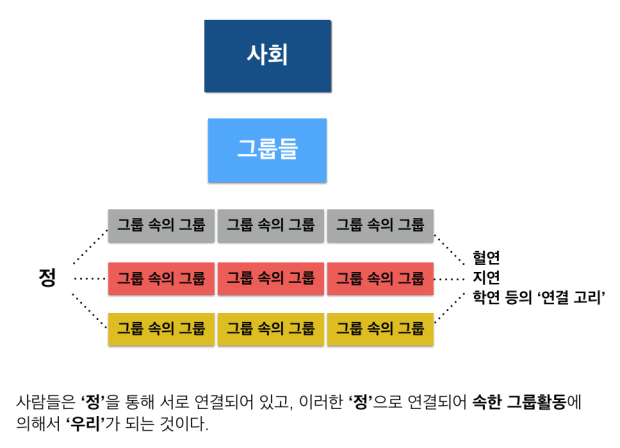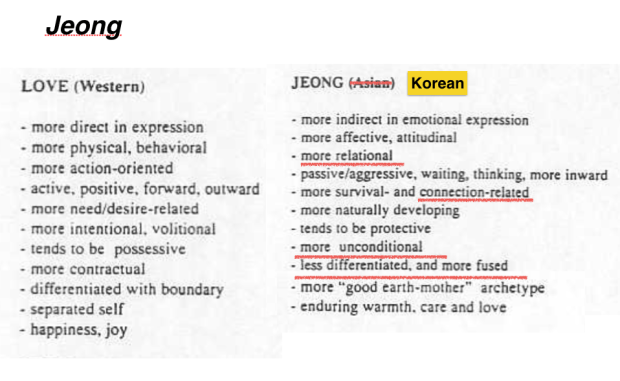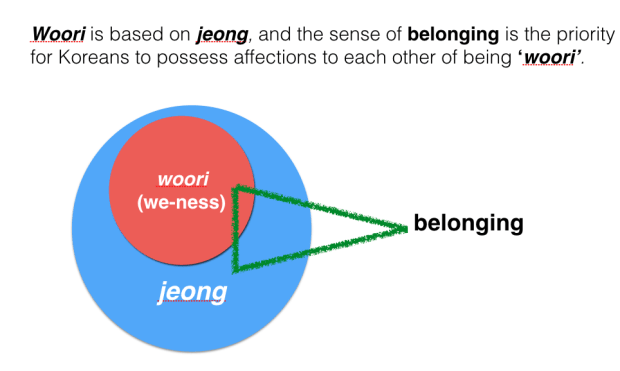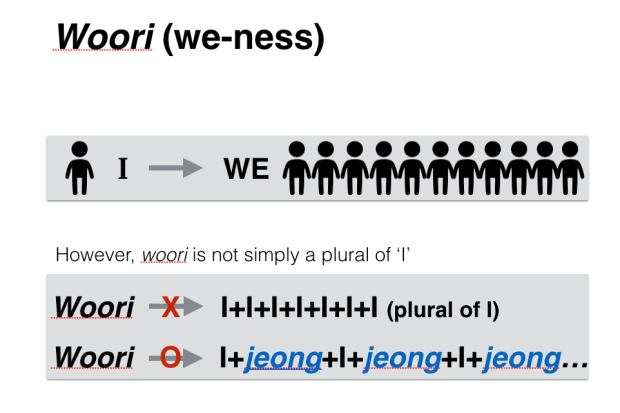정 이란 단어의 의미는 사실 설명하게 애매모호하다. 사랑과 비슷하지만 사랑과는 다르고, 그저 관심 혹은 애정이라고 말하기는 뭔가 부족해 보이는, 한 마디로 정은 그냥 정이다. 한글로도 설명하기 힘든 이 단어의 의미를 영어로 풀어내기란 더 어려운 일이다. 한국의 아줌마들에 대해서 그리고 한국 여성에 대한 챕터에 대해서 써내려 가면서 한국의 정에 관한 이야기를 빼놓을 수 없었는데, 이 ‘정’이란 놈은 뭐라고 말하기가 매우 어려워 골치를 썩었었던 기억이 난다. 사실 지금 이 포스팅을 쓰면서도, (영문버전)의 경우에 ‘정’에 대해 설명하는게 여전히 힘들고 고달펐다.
이러한 정의 의미에 대해서 학술적으로 풀어놓은 논문도 사실 많지는 않다. 정의 의미는 정이다. 정에 대해서 알고 싶으면 한국에 와서 한번 느껴봐라! 라고 할 수는 없는 노릇. 그래서 이것 저것 찾아보다가 가장 마음에 들게 써놓은 훌륭한 논문을 발견했는데, 그 내용은 아래와 같다.
“Jeong encompasses the meaning of a wide range of English terms: feeling, empathy, affection, closeness, tenderness, pathos, compassion, sentiment, trust, bonding and love… Koreans considers jeong an essential elements in human life, promoting the depth and richness of personal relations… With jeong, relationships are deeper and longer lasting… Jeong is what makes us say “we” rather than “I”, “ours” than “mine” (U Kim 1994, cited in Kim 1996, p.14)”.
정은 영어로 표현하자면 정말 다양한 의미로 해석될 수 있는데, 예를 들어 단순히 사랑하는 마음 뿐만이 아니라 미운정, 고운정 등과 같이 밉기도 하고 좋아하기도 하는 경우에 쓰여질 수 있다. 즉 우리네 인생살이에서 경험해지는 다양한 감정들이 바로 한국인이 생각하는 정인 것이다. 정을 통해서 한국인들은 좀 더 깊고 지속적인 관계를 유지할 수 있고, 이러한 정 때문에 우리는 ‘나’ 보다는 ‘우리’가 될 수 있었고 또한 ‘내것’이 아닌 ‘우리것’을 생각할 수 있던 것이다.
만약 나에게 누가 ‘정이 뭐야?’ 라고 물어본다면 나는 좀 생각을 해봐야 대답을 할 수 있을것 같다. 그게 한국어이든 영어이든 상관없이 그냥 정을 풀이하는 일은 매우 어렵다. 말로 풀어내기 어려운 이 정 이라는 것을 매일 느끼고 부딪히고 살아가고 있는게 참으로 아이러니 하다. 수십년동안 매일 함께 하고 있는 정을 이렇게 못 풀어내나?
뭐 정이라는 걸 서양문화에서 찾아본다면 ‘기본적인 매너’와 비슷하다고도 볼 수 있지만 이게 또 매너랑은 다른 뭔가가 더 있단 말이다. 한국문화에서 찾아볼 수 있는 그런 특이하고 따뜻한 때로는 귀찮아지기도 해서 오지랖 이라고 부르는 그 정. 정에 대해 설명 못하겠다라는 말을 지금 이 글을 쓰기 시작한 첫 문장부터 여기까지 계속 하고 있는데도 역시 딱히 한 문장으로 명쾌하게 설명해 낼 자신이 없다. 하지만 한가지 분명한 건, 정이라는 것은 교과서나 어떤 학문적인 교육을 통해 이뤄지는 것이 아니라 한국문화 속에서 매일 부딪히고 경험해 가며 알아가는 그러한 한국의 문화와 매우 밀접한 연관이 있다고 얘기할 수 있다. 즉, 한국에 와서 한 1년만 지내다 보면 그 ‘정’이라는게 뭔지 무릎을 탁 칠 날이 올 것이라는 것이다. 그래도, 굳이 학문적으로 설명을 해보고 싶어서 서양문화의 ‘사랑’과 우리의 ‘정’을 비교해 놓은 논문을 찾아 아래에 첨부했다. 사실 이 논문은 1990년대에 쓰여진 것이라 ‘동양’과 ‘서양’이라는 굉장히 이분법적으로 비교를 했지만 개인적으로 나는 ‘동양’과 ‘서양’이라고 말하기 보다 ‘서양’과 ‘한국’으로 나누고 싶었기에 Asian을 ‘한국’으로 고쳤다. (동양은 매우 넓고 문화와 역사가 서로 판이한 곳이 많으므로 동양을 하나의 문화로 보아서는 안된다고 생각한다. 사실 서양도 마찬가지이고)

Figure 1. (Kim 1996, p.15)
위에서 보면 정은 사랑보다 ‘관계를 중요시하고’, ‘연결성, 연, 연결고리’에 관심을 두고 있으며 보다 ‘무조건 적인’ 사랑이고 또한 ‘다름을 강조하기 보다는 함께 융합된 (튀는 것보다는 비슷하게 집단속에 함께 녹아져 있는-한국의 집단주의 참고)’것을 강조하는 것이라고 이야기 하고 있다. (번역이 좀 매끄럽지 못하지만 이해해 주시길 바랍니다)
따라서, 아줌마들 (모든 국민들도 함께)이 금모으기 운동과 같은것에 아무런 댓가없이도 그렇게 결혼반지며 돌반지를 들고 나올 수 있었던 건 바로 이러한 ‘정’ 때문이었다. ‘정’으로 뭉친 한국사회에서 살고 있는 ‘정’이 많은 사람들이 ‘우리’나라의 경제를 살리고자 그렇게 힘을 쏟아부었던 것이고, ‘정’때문에 모든것이 가능했었다고 나는 생각한다. (지금보다 과거의 우리사회는 훨씬 정이 넘치는 사회였었던것 같다)

그리고 또한 다양한 그룹들과 그 그룹속의 그룹에 ‘속함’으로써 한국 사람들은 그 속에서 ‘정’을 통해 ‘우리’가 될 수 있었다. 이러한 그룹은 보통 다양한 학연, 지연, 혈연등과 같은 ‘연결고리’를 통해 만들어지고 사람들이 속하게 된다. 같은 소속의 그룹에서 또 다시 ‘정’을 나누고 느끼며 ‘우리’가 되어가는 것이다.

한국에는 다양한 그룹들이 존재한다. ‘모임’이라고도 하고. 내가 대학에 다닐때에도 다양한 모임에 속해있었는데, 예를 들어 동네친구들 모임, 영어공부 모임, 동아리 모임, 고등학교 친구들 모임, 성당 모임, 스키동호회 모임 등등… 수많은 모임에 들어가고 그곳에서 나와 비슷한 연결고리를 가진 사람들을 알게되고 만나고 친해지는 등의 ‘정’을 나누면서 나와 그들은 ‘우리’가 될 수 있었다. 한국 사람들은 정말 모임을 좋아한다. 때로는 가고싶지 않은 모임이나 회식을 억지로 가야하는 이러한 한국의 정 문화 혹은 집단주의 문화가 귀찮고 불편하기도 하지만 그래도, 이런게 바로 한국의 정이 아닐까 생각이 든다. 사실 외국에 오래 나가 살면서 한국과 외국의 차이점을 여실히 느끼는 경우가 많았는데, 바로 이러한 모임이나 회식과 같은 문화가 정말 달랐다. 둘 다 장단점이 있지만 그래도 외국에 있다보니, 때론 귀찮고 불편했던 한국의 이런 회식이나 모임이 그리워졌었다.
정, 속함, 우리 이 세가지 요건이 반드시 모임이나 회식과 같은것에만 적용되는 것이다. 예를 들어, 전혀 알지 못했던 사람들과 짧은 시간에 만나 서로 인사를 할 틈도 없었지만 ‘우리’가 되고 ‘정’을 나누며 같은곳에 ‘속해있는’ 경험을 하게 되는 경우도 많다. 바로 떼창과 같은 경우! 나도 좋아하는 밴드가 있어서 공연장에 자주 가는데, 그 때 마다 한 번도 본 적 없고 앞으로도 따로 만날 일은 없을 것 같은 그 공연에 온 또 다른 팬들과 함께 같은 곳에서 같은 노래를 부르고 방방 뛰면서 ‘우리’가 되고 ‘정’을 나누는 희열을 느낀다. (아 또 공연 가고 싶어라!)
이렇게 ‘정’을 나누고 ‘우리’가 되는 한국의 사람들. 아줌마들이라는 집단도 그러한 것이다. 중년의 한국여성들, 비슷한 옷차림과 머리를 하고 ‘아줌마’로 불리우는 우리의 어머니들, 그들도 아줌마들끼리의 ‘정’을 나누고 ‘우리’가 되어 우리사회에 독특한 문화를 만들고 있는 것이다. 나는 그러한 아줌마들을 사랑하고 연구하고 있는 중이고!
다음 포스팅부터는 드디어 ‘스마트 아줌마’에 관한 이야기를 시작해보려고 한다.










